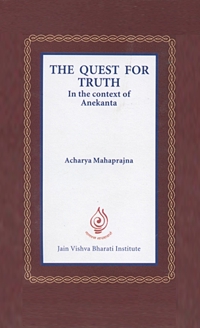
The first flow of consciousness takes place when the power of discernment is awakened. All bondages from the karmic body to kashaya (or the vicious energy field) drop off with the realization of the fact that the soul is different and the body is different.
Indeed what Acharya Amritchandra said is so true:
Bheda-vigyanatah siddhah siddha ye kila kechana Tasyaivabhavato baddhah baddha ye kila kechana
in this world only those are in karmic bondage who do not know the science of discernment. Only they have realized the soul who have understood discernment; have realized the real existence of sentience as separate from insentience. The moment this happens the root of karma gets shaken. The one who has understood the difference between sentience and insentience has understood the difference between kashaya and karma with the soul. This understanding targets the root source. It nips the source of kashaya from which the karmas are coming.
If the science of discernment is the primary cause of breaking the bondage of karma, the ignorance of discernment is the primary cause of karmic bondage. Acharya Amritchandra's words could be turned around and read as
Bhedavigyanato baddhah baddha ye kila kechana
Tasyaivabhavato siddhah siddha ye kila kechana
In this world those people are in karmic bondage who have not learnt the science of discernment.
Only those have found the soul who have learnt discernment, have realized the real existence of sentience as separate from non-sentience.
When one starts clearly realizing the difference between the pure soul and its encircling energy field, which is vitiating, the karmic bondage starts becoming loose. Those, who do not realize this difference and consider the soul and its encircled vitiating matter as similar and one, their bondage takes place and is of high intensity. Karma is matter and is thus non-sentient. Non-sentient elements can merge with pure sentience; in fact it is the state of the soul in the form of passions which assimilates the new influx of non-sentient matter through the karmic body. These karmic particles cannot get mingled with the liberated soul because there exists only the experience of pure consciousness in it. The moment of realizing the pure consciousness in the presence of karmic body is samvara i.e. stoppage of influx. In the absence of karmic body it becomes the nature of soul.
Experience of consciousness mixed with passion is the moment of influx because it attracts the karmic particles. Here works the law of similarity. Accordingly, like attracts like or there is attraction between elements of the same category. The consciousness mixed with passions is in itself the state of the soul vitiated with matter. This material part is responsible for attracting new matter. If we realize this essence then our spiritual background becomes much powerful. Let us try more and more to be in the state of pure consciousness, where there exists simply knowledge sans sensations, passions or emotions. This is the peak of spiritual practice.
Therefore Jaina Acharyas have used the word immaculate consciousness or shuddha upayog that is 'realization of only pure consciousness' for meditation. In the lack of spiritual practice there takes place binding of high intensity of karmas. They can be demolished only through this practice. Therefore it can be said that without knowing the secrets of spiritual practice one cannot understand the secrets of karma and vice-a-versa. The inflow of karmic bondage takes place through our strength of action and at that time our consciousness too takes its shape accordingly. The interpretative exposition of karmic theory in Jain Philosophy needs deep study in the context of psychology. If this happens, new dimensions will be added to both yoga and psychology and to the spiritual system of Jainism. Our soul undergoes transformations in accordance with our feelings/inclinations. In accordance with our feelings/inclinations, karmic matter gets bound to the soul. These karmic particles ripen by themselves. The transformation of the soul that takes place after ripening of the karmic matter becomes our intrinsic consciousness. This is a cycle. A certain person exhibits his scorn for knowledge and also presents the drawbacks of knowledge and the knower. The change taking place in him at that time will definitely have negative impact on knowledge. At that moment the karmic matter attracted by the soul would have its effect on all the powers of the soul, but its fruition will be in the form of obstructing the soul's power of knowledge. In this way other actions also take place. For instance if the new binding karmic matter brings an inclination to cheat, the person's conduct becomes deceitful. This is the law of change. It is very essential to know how we change and what karmic particles we attract. Understanding this law we can hope for success and can also overcome all the odds of life.
One who feels that knowledge obscuring karma is harassing him a lot should do the spiritual practice to weaken its effect accordingly. Some are harassed more by the problems of delusion while some others with obstacles to expression of their capabilities. All these are different kinds of problems. The solution to these problems is spiritual practice.
If one has to overcome anger he will have to practice differently and if another has to control mind then there should be some other technique of overcoming it. We should target the root of the Problem with which we have to grapple and select the sadhana accordingly. This is a very subtle system. If we unravel this secret we would have unlocked the door for solutions to all the world's problems.
 Acharya Mahaprajna
Acharya Mahaprajna


